Identification of Clinical Prognostic Regulators and Analysis of Ferroptosis-Related Signatures in the Tumor Immune Microenvironment in Lung Squamous Cell Carcinoma
- PMID: 36845013
- PMCID: PMC9946749
- DOI: 10.1155/2023/9155944
Identification of Clinical Prognostic Regulators and Analysis of Ferroptosis-Related Signatures in the Tumor Immune Microenvironment in Lung Squamous Cell Carcinoma
Retraction in
-
Retracted: Identification of Clinical Prognostic Regulators and Analysis of Ferroptosis-Related Signatures in the Tumor Immune Microenvironment in Lung Squamous Cell Carcinoma.Dis Markers. 2023 Jun 21;2023:9893453. doi: 10.1155/2023/9893453. eCollection 2023. Dis Markers. 2023. PMID: 37387739 Free PMC article.
Abstract
Objective: Lung squamous cell carcinoma (LUSC) is a common respiratory malignancy and presents an increasing prevalence. Ferroptosis is a newly identified controlled cell death that has captured clinical attention worldwide. However, the ferroptosis-related lncRNA expression in LUSC and its relevance to prognosis remain elusive.
Methods: The research measured predictive ferroptosis-related lncRNAs in LUSC samples from the TCGA datasets. Data on the stemness indices (mRNAsi) and corresponding clinical characteristics were obtained from TCGA. A prognosis model was established using the LASSO regression. Changes within the neoplasm microenvironment (TME) and medicine association were examined to grasp higher immune cell infiltration in numerous risk teams. In line with coexpression studies, the expression of lncRNAs is closely associated with that of ferroptosis. They were overexpressed in unsound people in the absence of alternative clinical symptoms.
Results: The low-risk and speculative teams were considered to have substantial differences in CCR and inflammation-promoting genes. C10orf55, AC016924.1, AL161431.1, LUCAT1, AC104248.1, and MIR3945HG were highly expressed in the high-risk group, suggesting their involvement in the oncology process of LUSC. Moreover, AP006545.2 and AL122125.1 were considerably higher in the low-risk group, implying the potential of these genes as LUSC tumor suppressor genes. The biomarkers listed above may serve as therapeutic targets for LUSC. lncRNAs were also linked to patient outcomes in the LUSC trial.
Conclusion: lncRNAs of ferroptosis were overexpressed in the high-risk cohort without other clinical signs, implying their potential to predict BLCA prognosis. GSEA highlighted immunological and tumor-related pathways in the high-risk group. LUSC occurrence and progression are linked to lncRNAs of ferroptosis. Corresponding prognostic models help forecast the prognosis of LUSC patients. lncRNAs of ferroptosis and associated immune cell infiltration in the tumor microenvironment (TME) may serve as potential therapeutic targets in LUSC, which requires further trials. In addition, the lncRNAs of ferroptosis signature offer a viable alternative to predict LUSC, and these ferroptosis-lncRNAs show a prospective research area for LUSC-targeted treatment in the future.
Copyright © 2023 Wentao Wang et al.
Conflict of interest statement
The authors declare that they have no conflicts of interest.
Figures
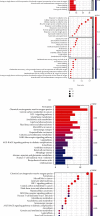

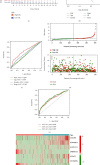
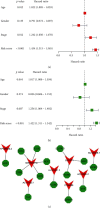


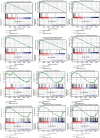

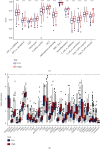

Similar articles
-
Genetic profile of ferroptosis in non-small cell lung carcinoma and pharmaceutical options for ferroptosis induction.Clin Transl Oncol. 2025 May;27(5):1867-1886. doi: 10.1007/s12094-024-03754-4. Epub 2024 Oct 26. Clin Transl Oncol. 2025. PMID: 39460894 Review.
-
M7G-Related lncRNAs predict prognosis and regulate the immune microenvironment in lung squamous cell carcinoma.BMC Cancer. 2022 Nov 4;22(1):1132. doi: 10.1186/s12885-022-10232-z. BMC Cancer. 2022. PMID: 36333719 Free PMC article.
-
Identification and validation of an individualized prognostic signature of lung squamous cell carcinoma based on ferroptosis-related genes.Thorac Cancer. 2021 Dec;12(23):3236-3247. doi: 10.1111/1759-7714.14195. Epub 2021 Oct 20. Thorac Cancer. 2021. PMID: 34672420 Free PMC article.
-
Systematic analysis of ferroptosis-related long non-coding RNA predicting prognosis in patients with lung squamous cell carcinoma.Transl Lung Cancer Res. 2022 Apr;11(4):632-646. doi: 10.21037/tlcr-22-224. Transl Lung Cancer Res. 2022. PMID: 35529787 Free PMC article.
-
Decoding LncRNA in COPD: Unveiling Prognostic and Diagnostic Power and Their Driving Role in Lung Cancer Progression.Int J Mol Sci. 2024 Aug 19;25(16):9001. doi: 10.3390/ijms25169001. Int J Mol Sci. 2024. PMID: 39201688 Free PMC article. Review.
Cited by
-
Unveiling the Network regulatory mechanism of ncRNAs on the Ferroptosis Pathway: Implications for Preeclampsia.Int J Womens Health. 2024 Sep 30;16:1633-1651. doi: 10.2147/IJWH.S485653. eCollection 2024. Int J Womens Health. 2024. PMID: 39372667 Free PMC article. Review.
-
Retracted: Identification of Clinical Prognostic Regulators and Analysis of Ferroptosis-Related Signatures in the Tumor Immune Microenvironment in Lung Squamous Cell Carcinoma.Dis Markers. 2023 Jun 21;2023:9893453. doi: 10.1155/2023/9893453. eCollection 2023. Dis Markers. 2023. PMID: 37387739 Free PMC article.
-
Genetic profile of ferroptosis in non-small cell lung carcinoma and pharmaceutical options for ferroptosis induction.Clin Transl Oncol. 2025 May;27(5):1867-1886. doi: 10.1007/s12094-024-03754-4. Epub 2024 Oct 26. Clin Transl Oncol. 2025. PMID: 39460894 Review.
References
Publication types
MeSH terms
Substances
LinkOut - more resources
Full Text Sources
Medical

